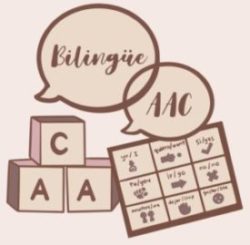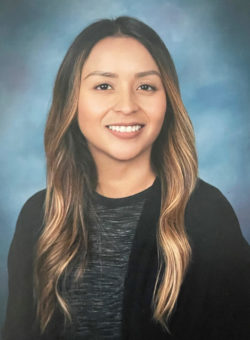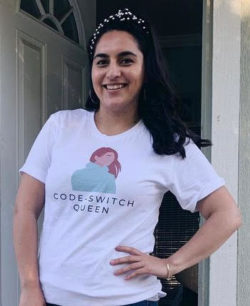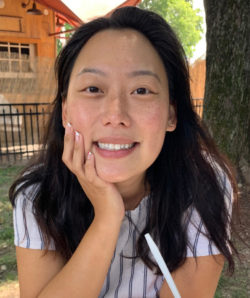Bilingual AAC Support from Monolingual Professionals: An Introduction

 Welcome to the first post in a series by BilingüeAAC on supporting individuals with AAC needs in Spanish. In today’s post, they introduce us to the series focusing on ways that monolingual therapists can better support Spanish bilingual individuals who are AAC users.
Welcome to the first post in a series by BilingüeAAC on supporting individuals with AAC needs in Spanish. In today’s post, they introduce us to the series focusing on ways that monolingual therapists can better support Spanish bilingual individuals who are AAC users.
BilingüeAAC is a group of SLPs with a shared belief in providing evidence-based intervention strategies and resources to bilingual Spanish AAC clients, families, caregivers, and professionals.
:::::::::::::::::::::::::::::::::::::::::::::::::::::::::::::
A Monolingual SLP’s Guide to Demystifying CLD Practices for Bilingual Spanish AAC Intervention
If all languages hold unique systematic rules, can we translate English AAC core words to Spanish and begin modeling? What about morpho-syntax? What about inclusive practices? How can monolingual therapists provide culturally linguistically responsive intervention to their bilingual clients?
BILINGUAL AAC USERS
Currently, there is limited research on the number of Spanish-speaking AAC users and providers. However, according to the Demographic Profile of ASHA Members Providing Bilingual Services Year-end 2020, there are currently 10, 208 Spanish language service providers- a 2% increase from 2019. In Andzik et al. (2018) research survey of 4,000 special educators, 18.2% of over 15,000 students used AAC. The U.S. Census Bureau American Community Survey (2016) shows 22% of children ages 5-17 spoke a language other than English at home, with particular increases in Florida, Arizona, and California (Kids Count Data Center). Therefore, we can surmise that there are not enough bilingual Spanish SLPs available to provide bilingual therapy for our growing Spanish-speaking client population. We can assume millions of bilingual children in the US have severe speech and language needs, and many use AAC (King, Romski, & Sevcik, 2021).
Realistically, SLPs will not know the languages and cultures of every client on their caseload. Still, they can create a climate where different language practices are included and legitimized, where clients and their families feel proud of their native language, and where their bilingualism can be used to support language development (SFSU Culturally Responsive AAC Website https://aac.sfsu.edu/content/multicultural-aac).
WHY SHOULD SLPs CONSIDER A CULTURAL LINGUISTIC APPROACH IN AAC ASSESSMENTS AND INTERVENTIONS
- Intervention acknowledging the home language and culture and supporting bilingual development benefits the majority language and the home language (Restrepo, Morgan, & Thompson, 2013).
- The failure to include long-term development and maintenance of both languages for bilingual children limits opportunities to practice and generalize linguistic skills across contexts and hinders interpersonal relationships with family members (Soto & Yu, 2014).
- ASHA Code of Ethics states, “SLPs are obligated to provide culturally-linguistically appropriate services to their clients and patients, regardless of the clinician’s culture, practice setting, or caseload demographics.”
Most of us, monolingual SLPs, WANT to provide culturally-linguistically responsive bilingual Spanish AAC service. Still, we don’t feel confident without knowing/speaking the language, or we don’t know where to begin. Here is some good news! There are still so many inclusive practices we can do as monolingual therapists. We are here to help empower the monolingual SLP to support the Spanish-speaking household and encourage families to use their native language.
In this year-long series on providing culturally-linguistically affirming practices for bilingual Spanish AAC users as monolingual therapists, we will be exploring:
- An easy-to-use framework and best practices when approaching bilingual families
- How to collaborate with interpreters, caregivers, families, and/or pertinent communication partners
- Spanish lexicon research, tools, and resources (Check out our 36 bilingual Spanish/English core boards!)
- Bi-literacy ideas and resources (tell me más, too many tamales, and more!)
- Suggested inclusive practices for the classroom or clinic!
:::::::::::::::::::::::::::::::::::::::::::::::::::::::::::::::::::::::::::::::::
About the Guest Authors
- Maria De Leon is a bilingual Speech-Language Pathologist specializing in AAC. She received her Bachelor’s degree in Sociology at the
 University of California Los Angeles and her Master’s degree in Speech-Language Pathology at San Francisco State University. She participated in “Project Building Bridges” and graduated with a specialization in culturally responsive AAC. Maria currently works at a non-profit organization as a speech-language pathologist providing AAC services to Southern California. She focuses on giving back to communities like the one she grew up in and spreading information about best cultural practices. Maria manages the Instagram account, @code.switch.slp.
University of California Los Angeles and her Master’s degree in Speech-Language Pathology at San Francisco State University. She participated in “Project Building Bridges” and graduated with a specialization in culturally responsive AAC. Maria currently works at a non-profit organization as a speech-language pathologist providing AAC services to Southern California. She focuses on giving back to communities like the one she grew up in and spreading information about best cultural practices. Maria manages the Instagram account, @code.switch.slp.
- A
 lma M. Partida is a bilingual and bicultural Speech-Language Pathologist specializing in AAC. Alma graduated from San Jose State with her Bachelor’s in Communicative Sciences and Disorders and a minor in Psychology. She completed her graduate studies at San Jose State where she received the Project AACes grant. She currently practices as an SLP and AAC consultant in Northern California with preschool and early elementary-aged students. She is also a community partner and lecturer at CSU-Monterey Bay. Alma manages the Instagram accounts @AACForYouandMe and @DiverseAAC.
lma M. Partida is a bilingual and bicultural Speech-Language Pathologist specializing in AAC. Alma graduated from San Jose State with her Bachelor’s in Communicative Sciences and Disorders and a minor in Psychology. She completed her graduate studies at San Jose State where she received the Project AACes grant. She currently practices as an SLP and AAC consultant in Northern California with preschool and early elementary-aged students. She is also a community partner and lecturer at CSU-Monterey Bay. Alma manages the Instagram accounts @AACForYouandMe and @DiverseAAC.
 Melissa Tapia is a bicultural and bilingual Speech-Language Pathologist in Illinois. She attended Illinois State University for both undergraduate and graduate studies, majoring in Communication Sciences and Disorders and Spanish Language, Literature, and Cultures. Melissa is the owner and founder of Hablame Speech Therapy. She focuses on a client-centered collaborative model with bilingual families through in-home therapy services. She believes in helping AAC users gain access to communication in their immediate and most comfortable environment using various communication modalities and educating caregivers in how to best support their children together. Melissa manages the Instagram account, @hablame_de_language.
Melissa Tapia is a bicultural and bilingual Speech-Language Pathologist in Illinois. She attended Illinois State University for both undergraduate and graduate studies, majoring in Communication Sciences and Disorders and Spanish Language, Literature, and Cultures. Melissa is the owner and founder of Hablame Speech Therapy. She focuses on a client-centered collaborative model with bilingual families through in-home therapy services. She believes in helping AAC users gain access to communication in their immediate and most comfortable environment using various communication modalities and educating caregivers in how to best support their children together. Melissa manages the Instagram account, @hablame_de_language.
 Sarah Lee is a monolingual Speech-Language Pathologist certified in NY, CA, and Or. She has worked within school and early intervention settings across all 3 states specializing in AAC. She has a Master’s of Science in Speech-Language Pathology from Western Kentucky University and a Master’s of Science in Neuroscience and Education from Teacher’s College, Columbia University. Sarah believes in evidence-based, innovative intervention strategies and synthesizing literature to practice. She manages the Instagram account, @AAC_together.
Sarah Lee is a monolingual Speech-Language Pathologist certified in NY, CA, and Or. She has worked within school and early intervention settings across all 3 states specializing in AAC. She has a Master’s of Science in Speech-Language Pathology from Western Kentucky University and a Master’s of Science in Neuroscience and Education from Teacher’s College, Columbia University. Sarah believes in evidence-based, innovative intervention strategies and synthesizing literature to practice. She manages the Instagram account, @AAC_together.
BilingüeAAC: www.BilingueAAC.com
Instagram: @bilingueaac
Facebook Group: BilingüeAAC
TPT: BilingueAAC
Filed under: Featured Posts
This post was written by Carole Zangari
